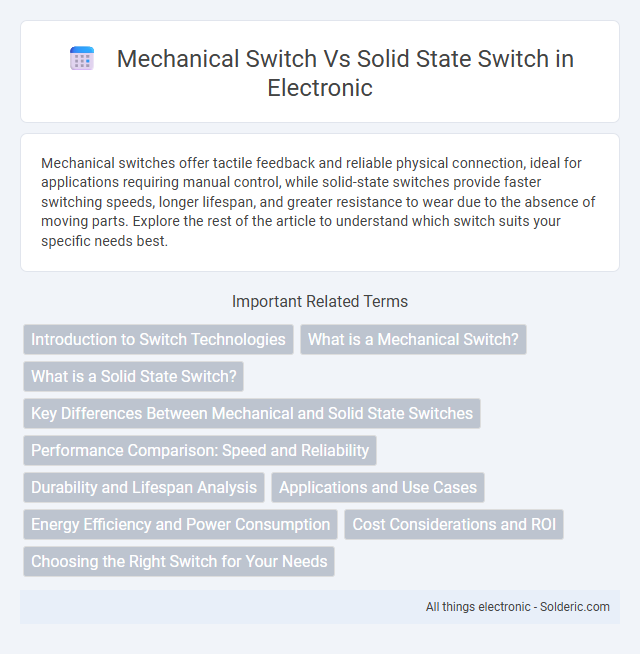Mechanical switches offer tactile feedback and reliable physical connection, ideal for applications requiring manual control, while solid-state switches provide faster switching speeds, longer lifespan, and greater resistance to wear due to the absence of moving parts. Explore the rest of the article to understand which switch suits your specific needs best.
Comparison Table
| Feature | Mechanical Switch | Solid State Switch |
|---|---|---|
| Operation | Physical contact opens/closes circuit | Electronic components control circuit without moving parts |
| Durability | Limited, subject to wear and tear (typically 1M to 10M cycles) | High, no moving parts, often >100M cycles |
| Switching Speed | Slower (milliseconds range) | Faster (microseconds to nanoseconds) |
| Noise | Audible click sound | Silent operation |
| Power Consumption | Minimal, no power needed to maintain state | Consumes power to maintain switching state |
| Reliability | Mechanical wear can cause failure | High reliability with less maintenance |
| Cost | Generally lower initial cost | Higher initial cost but lower maintenance |
| Applications | Light switches, keyboards, relays | Telecom, industrial automation, computers |
Introduction to Switch Technologies
Mechanical switches feature physical contacts that open or close circuits through manual actuation, offering tactile feedback and durability in various applications. Solid-state switches utilize semiconductor devices like transistors to control electrical flow without moving parts, enabling faster switching speeds and longer lifespan. These fundamental differences influence performance factors such as response time, reliability, and electrical noise, critical in designing modern electronic and communication systems.
What is a Mechanical Switch?
A mechanical switch is an electromechanical device that physically opens or closes an electrical circuit through the movement of metal contacts. It relies on mechanical components such as springs and levers to create a tactile and audible response during operation, providing clear feedback to the user. Commonly used in applications like keyboards, relays, and industrial controls, mechanical switches are valued for their durability and distinct actuation feel.
What is a Solid State Switch?
A solid state switch uses semiconductor devices like transistors or thyristors to control electrical current without any moving parts, offering faster switching speeds and greater durability compared to mechanical switches. These switches provide reliable performance with minimal wear, making them ideal for applications requiring frequent switching and long operational life. Understanding how a solid state switch operates can help you select the best switch type for electronic circuits needing efficient and silent operation.
Key Differences Between Mechanical and Solid State Switches
Mechanical switches utilize physical moving parts that create or break a circuit through direct contact, offering tactile feedback and audible clicks. Solid state switches depend on semiconductor components like transistors or thyristors to control current flow without moving parts, resulting in faster switching speeds and greater durability. The key differences involve mechanical wear and noise in mechanical switches versus silent operation and longer lifespan in solid state switches.
Performance Comparison: Speed and Reliability
Mechanical switches offer tactile feedback and durability with typical actuation speeds around 5 milliseconds, but their moving parts can wear out over time, affecting reliability. Solid state switches provide faster switching speeds in microseconds and higher reliability due to the lack of mechanical components, reducing failure rates and maintenance needs. Your choice impacts system performance, where solid state switches excel in speed and longevity, while mechanical switches may be preferred for applications needing physical feedback.
Durability and Lifespan Analysis
Mechanical switches typically offer a lifespan of 1 to 10 million actuations due to their physical moving parts, which can wear out over time, whereas solid-state switches boast significantly higher durability with lifespans exceeding 100 million cycles because they operate without mechanical movement. The absence of mechanical wear in solid-state switches results in more consistent performance and lower maintenance requirements, ideal for high-frequency switching applications. Your choice between the two should consider the operational environment and expected usage intensity to optimize reliability and longevity.
Applications and Use Cases
Mechanical switches excel in applications requiring tactile feedback and durability, such as industrial machinery controls, household appliances, and automotive switches. Solid state switches are preferred in high-speed, high-frequency electronics and semiconductor devices due to their fast switching, reliability, and absence of mechanical wear. Solid state designs dominate in power management systems, telecommunication equipment, and consumer electronics where silent operation and longevity are critical.
Energy Efficiency and Power Consumption
Mechanical switches typically consume more power due to physical contact resistance and potential energy loss during switching, while solid-state switches, using semiconductor components, offer higher energy efficiency with minimal power dissipation. Your choice of switch significantly impacts overall system power consumption, especially in applications requiring frequent or rapid switching. Solid-state switches are generally preferred for low-power and energy-sensitive designs because they reduce heat generation and improve longevity through efficient energy use.
Cost Considerations and ROI
Mechanical switches generally incur higher upfront costs due to complex manufacturing and durable materials, while solid-state switches offer lower initial expenses and reduced maintenance needs. Solid-state switches provide faster switching speeds and longer lifespan, resulting in lower total cost of ownership and improved ROI over time. Investing in solid-state technology typically leads to energy savings and less downtime, making it more cost-effective for industrial automation and high-frequency applications.
Choosing the Right Switch for Your Needs
Mechanical switches offer tactile feedback and durability, making them ideal for applications requiring precise control and reliability, such as industrial machinery and gaming keyboards. Solid state switches provide faster operation, longer lifespan, and resistance to wear and environmental factors, suited for high-speed electronics and automated systems. Evaluating factors like response time, environmental conditions, and maintenance requirements ensures selecting the optimal switch type for specific performance needs.
mechanical switch vs solid state switch Infographic

 solderic.com
solderic.com